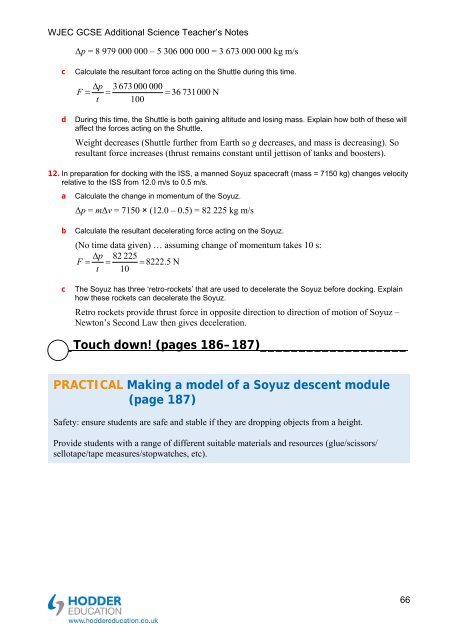Teacher's notes and answers to questions in the book - Hodder Plus ...
Teacher's notes and answers to questions in the book - Hodder Plus ...
Teacher's notes and answers to questions in the book - Hodder Plus ...
Create successful ePaper yourself
Turn your PDF publications into a flip-book with our unique Google optimized e-Paper software.
WJEC GCSE Additional Science Teacher’s Notes<br />
Δp = 8 979 000 000 – 5 306 000 000 = 3 673 000 000 kg m/s<br />
c<br />
Calculate <strong>the</strong> resultant force act<strong>in</strong>g on <strong>the</strong> Shuttle dur<strong>in</strong>g this time.<br />
p<br />
F t<br />
<br />
3 673 000 000<br />
36 731000 N<br />
100<br />
d Dur<strong>in</strong>g this time, <strong>the</strong> Shuttle is both ga<strong>in</strong><strong>in</strong>g altitude <strong>and</strong> los<strong>in</strong>g mass. Expla<strong>in</strong> how both of <strong>the</strong>se will<br />
affect <strong>the</strong> forces act<strong>in</strong>g on <strong>the</strong> Shuttle.<br />
Weight decreases (Shuttle fur<strong>the</strong>r from Earth so g decreases, <strong>and</strong> mass is decreas<strong>in</strong>g). So<br />
resultant force <strong>in</strong>creases (thrust rema<strong>in</strong>s constant until jettison of tanks <strong>and</strong> boosters).<br />
12. In preparation for dock<strong>in</strong>g with <strong>the</strong> ISS, a manned Soyuz spacecraft (mass = 7150 kg) changes velocity<br />
relative <strong>to</strong> <strong>the</strong> ISS from 12.0 m/s <strong>to</strong> 0.5 m/s.<br />
a Calculate <strong>the</strong> change <strong>in</strong> momentum of <strong>the</strong> Soyuz.<br />
Δp = mΔv = 7150 × (12.0 – 0.5) = 82 225 kg m/s<br />
b Calculate <strong>the</strong> resultant decelerat<strong>in</strong>g force act<strong>in</strong>g on <strong>the</strong> Soyuz.<br />
(No time data given) … assum<strong>in</strong>g change of momentum takes 10 s:<br />
p<br />
82 225<br />
F 8222.5 N<br />
t 10<br />
c<br />
The Soyuz has three ‘retro-rockets’ that are used <strong>to</strong> decelerate <strong>the</strong> Soyuz before dock<strong>in</strong>g. Expla<strong>in</strong><br />
how <strong>the</strong>se rockets can decelerate <strong>the</strong> Soyuz.<br />
Retro rockets provide thrust force <strong>in</strong> opposite direction <strong>to</strong> direction of motion of Soyuz –<br />
New<strong>to</strong>n’s Second Law <strong>the</strong>n gives deceleration.<br />
_Touch down! (pages 186–187)___________________<br />
PRACTICAL Mak<strong>in</strong>g a model of a Soyuz descent module<br />
(page 187)<br />
Safety: ensure students are safe <strong>and</strong> stable if <strong>the</strong>y are dropp<strong>in</strong>g objects from a height.<br />
Provide students with a range of different suitable materials <strong>and</strong> resources (glue/scissors/<br />
sellotape/tape measures/s<strong>to</strong>pwatches, etc).<br />
66

















